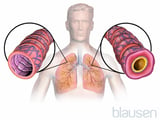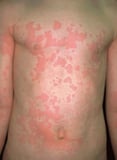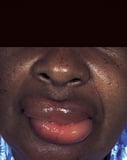On Hcg but Allergic to Chicken and Beef
A food allergy is an allergic reaction to a particular food.
-
Food allergies are commonly triggered by certain nuts, peanuts, shellfish, fish, milk, eggs, wheat, and soybeans.
-
Symptoms vary by age and may include rashes, wheezing, a runny nose, and, occasionally in adults, more serious symptoms.
-
Skin prick tests, blood tests, and an elimination diet may help doctors identify the food triggering the allergy.
-
The only effective treatment is to eliminate the food from the diet.
Food allergies may start during infancy. Children may outgrow a food allergy. Thus, food allergies are less common among adults. But if adults have food allergies, the allergies tend to persist throughout life.
Food allergies are sometimes blamed for such disorders as hyperactivity in children, chronic fatigue, arthritis, and depression, as well as poor athletic performance. However, these associations have not been substantiated.
Some reactions to food are not an allergic reaction.
Other reactions to a food may result from contamination or deterioration of the food.
In some people, food additives can cause a reaction that resembles but is not an allergic reaction. For example, some preservatives (such as metabisulfite) and dyes (such as tartrazine, which is a yellow dye used in candies, soft drinks, and other foods) can cause symptoms such as asthma Asthma Asthma is a condition in which the airways narrow—usually reversibly—in response to certain stimuli. Coughing, wheezing, and shortness of breath that occur in response to specific triggers are... read more  and hives Hives Hives are red, itchy, slightly elevated swellings. The swelling is caused by the release of chemicals (such as histamine) from mast cells in the skin, which cause fluid to leak out of small... read more
and hives Hives Hives are red, itchy, slightly elevated swellings. The swelling is caused by the release of chemicals (such as histamine) from mast cells in the skin, which cause fluid to leak out of small... read more  . Similarly, eating certain foods, such as cheese, wine, and chocolate, triggers migraine headaches Migraines A migraine headache is typically a pulsating or throbbing pain that ranges from moderate to severe. It can affect one or both sides of the head. It is often worsened by physical activity, light... read more in some people.
. Similarly, eating certain foods, such as cheese, wine, and chocolate, triggers migraine headaches Migraines A migraine headache is typically a pulsating or throbbing pain that ranges from moderate to severe. It can affect one or both sides of the head. It is often worsened by physical activity, light... read more in some people.
Almost any food or food additive can cause an allergic reaction. The most common triggers vary by age group.
Infants and young children with food allergies tend to be allergic to the most common allergy triggers (allergens), such as those in the following:
-
Eggs
-
Milk
-
Wheat
-
Peanuts
-
Soybeans
To prevent such allergies from developing, many parents avoid exposing their young children to these foods. However, new evidence suggests that regularly feeding infants foods that contain peanuts may help prevent them from developing a peanut allergy. More study of this approach is needed.
For older children and adults, the most common triggers are allergens in
-
Nuts
-
Seafood
Being exposed to other allergens that are similar to those in foods (such as pollen) may trigger the production of antibodies to substances in food, resulting in a food allergy. This process is called sensitization. For example, children with peanut allergy may have been sensitized to peanuts when topical creams containing peanut oil were used to treat rashes. Also, many people who are allergic to latex are also allergic to bananas, kiwis, avocados, or a combination. Latex and these fruits contain similar allergens.
Symptoms of food allergies vary depend on which food causes the allergy and how old the person is.
When food allergies persist in older children and adults, reactions tend to be more severe. In adults, food allergies cause itching in the mouth, hives, eczema, swelling (angioedema Angioedema Angioedema is swelling of areas of tissue under the skin, sometimes affecting the face and throat. Angioedema can be a reaction to a drug or other substance (trigger), a hereditary disorder... read more  ), and, occasionally, a runny nose and asthma. Food allergies sometimes cause symptoms such as light-headedness or fainting.
), and, occasionally, a runny nose and asthma. Food allergies sometimes cause symptoms such as light-headedness or fainting.
Some allergic reactions to food take hours to develop and cause symptoms such as abdominal pain, nausea, cramping, and diarrhea.
-
Skin prick tests or an allergen-specific immunoglobulin test
-
An elimination diet
If either test identifies a particular food, that food is eliminated from the diet. If eliminating the food relieves symptoms, the food is given to the person again to see whether symptoms develop after it is eaten. When possible, this step is done as part of an oral challenge test. The oral challenge test is done to confirm the diagnosis.
In an oral challenge test, the person is given another food (such as milk or applesauce) in two batches: one with the suspected food in it and one without the suspected food in it. Then the doctor observes as the person eats the food:
-
If no symptoms develop after the suspected food is eaten, the person is not allergic to the food.
-
If symptoms develop after the suspected food is eaten and not after the other food is eaten, the person is probably allergic to the suspected food.
Other ways to identify a food allergy include elimination diets:
-
A diet that eliminates only the food or foods suspected of causing the allergy
-
A diet that consists only of foods not likely to cause an allergic reaction
An elimination diet may be the only test used to diagnose a food allergy or may be used after a skin prick test or an allergen-specific serum IgE test.
For the first type of elimination diet, the person stops eating all foods that may be causing the symptoms for about 1 week.
The second type of elimination diet, which consists of food not likely to cause allergic reactions, can be tried instead of the first type of diet. The second type of diet involves the following:
-
Following a diet prescribed by the doctor
-
Eating only the foods and liquids specified in the diet and only using pure products (which excludes many commercially prepared foods)
There are several possible elimination diets, which vary in the foods that are eliminated and allowed. For example, one diet may eliminate beef and lamb and allow chicken. Another may eliminate lamb and poultry and allow beef.
Following an elimination diet is not easy because many food products have ingredients that are not obvious or expected. For example, many rye breads contain some wheat flour. Eating in restaurants is not advisable because the person and the doctor need to know the ingredients of every meal eaten.
If symptoms are not relieved after 1 week, doctors may recommend a different elimination diet.
If no symptoms occur, foods are added back one at a time. Each added food is given for more than 24 hours or until symptoms appear, and thus the allergen is identified. Or the doctor may ask the person to eat a small amount of a food in the office. The doctor then observes the person's reaction to the food.
For many years, doctors have advised against feeding young infants foods that commonly trigger an allergic reaction (such as peanuts) as a way to prevent food allergies. However, new evidence suggests that regularly feeding infants foods that contain peanuts may help prevent them from developing a peanut allergy. More study of this approach is needed.
Parents should talk to their pediatrician about the best way to prevent peanut allergy in their child.
-
An elimination diet
-
Drugs to relieve symptoms
People with food allergies must eliminate the foods that trigger their allergies from their diet.
Desensitization by first eliminating the food, then eating small amounts of the food, or by placing drops of food extracts under the tongue is being studied. For example, there is a new peanut preparation that helps make people with peanut allergy less sensitive to peanuts.
Antihistamines are useful only for relieving hives and swelling. Cromolyn, taken by mouth, can also relieve symptoms. This form of cromolyn is available only by prescription.
People with severe food allergies should carry antihistamines to take immediately if a reaction starts. They should also carry a self-injecting syringe of epinephrine to use when needed for severe reactions.
Source: https://www.msdmanuals.com/home/immune-disorders/allergic-reactions-and-other-hypersensitivity-disorders/food-allergy
0 Response to "On Hcg but Allergic to Chicken and Beef"
Publicar un comentario